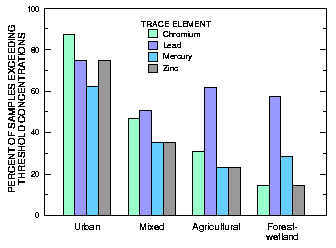The trace elements antimony, arsenic, cadmium, chromium, copper, lead, mercury, nickel, silver, and zinc are included in the USEPA list of priority pollutants which may have adverse effects on aquatic life. Trace elements in streambed sediments are derived from a variety of sources. Natural sources include the weathering of soils and bedrock. Anthropogenic sources include atmospheric deposition, stormwater runoff, wastewater discharges, landfills, automobile exhaust, fertilizer, inorganic pesticides, and industrial emissions.
Long and Morgan (1991) developed criteria called "effects-range thresholds" for use in assessing the effects of differing concentrations of trace elements on aquatic organisms. They computed threshold concentrations for each element. When a trace element concentration exceeds the threshold, some aquatic organisms could be adversely affected.
One or more trace elements exceeded threshold concentrations in streambed sediments from most sites.In the study area, the threshold concentration of one or more trace elements was exceeded at 83 percent of all sites. Lead, chromium, mercury, and zinc exceeded threshold concentrations most often. Lead concentrations exceeded thresholds at 57 percent of all sites. Concentrations of antimony, arsenic, and cadmium did not exceed threshold concentrations. |
|
|
The percentage of trace elements exceeding threshold concentrations in streambed sediments was related to land use. Threshold concentrations of lead, chromium, mercury and zinc were exceeded in at least 60 percent of sites in urban areas. Threshold concentrations were exceeded less frequently in mixed, agricultural, and forest-wetland areas, with the exception of lead. Lead exceeded the threshold concentration in more than 50 percent of the sites in all land-use categories. |

Chromium, lead, mercury, and zinc exceeded threshold concentrations most frequently in streambed sediment samples from urban basins.
The percentage of sites with lead and mercury exceeding threshold concentrations in forest-wetland basins is of concern because these basins are relatively pristine. The sources of these two elements in concentrations of concern could be due to (1) the natural weathering of bedrock and soils in the basin, (2) atmospheric deposition from the burning of fossil fuels, or (3) other previous activities in the basin.
Last modified: April 14, 1998 10:45 am